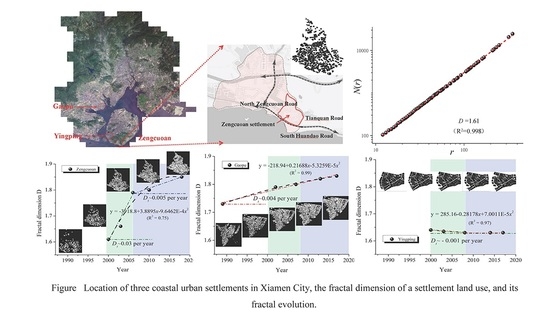Fractal Characteristic Evolution of Coastal Settlement Land Use: A Case of Xiamen, China
Abstract
:1. Introduction
2. Materials and Methods
2.1. Fractals
2.2. Nonlinear Evolution Equation
3. Results and Discussion
3.1. Land Use of the Studied Coastal Settlements
3.2. Fractal Characteristics of the Coastal Settlement Land Use
3.3. Fractal Evolution of the Settlement Land Use
4. Conclusions
Author Contributions
Funding
Data Availability Statement
Acknowledgments
Conflicts of Interest
References
- Eger, S.L.; Courtenay, S.C. Integrated coastal and marine management: Insights from lived experiences in the Bay of Fundy, Atlantic Canada. Ocean. Coast. Manag. 2021, 204, 105457. [Google Scholar] [CrossRef]
- Li, R.; Dong, L.; Zhang, J.; Wang, X.; Wang, W.X.; Di, Z.; Stanley, H.E. Simple spatial scaling rules behind complex cities. Nat. Commun. 2017, 8, 1841. [Google Scholar] [CrossRef] [Green Version]
- Batty, M.; Longley, P.A. The fractal simulation of urban structure. Environ. Plan. A Econ. Space 1986, 18, 1143–1179. [Google Scholar] [CrossRef]
- Purevtseren, M.; Tsegmid, B.; Indra, M.; Sugar, M. The fractal geometry of urban land use: The case of Ulaanbaatar city, Mongolia. Land 2018, 7, 67. [Google Scholar] [CrossRef] [Green Version]
- Pérez-Campuzano, E.; Guzmán-Vargas, L.; Angulo-Brown, F. Distributions of city sizes in Mexico during the 20th century. Chaos Soliton Fractals 2015, 73, 64–70. [Google Scholar] [CrossRef]
- Chen, Y. A set of formulae on fractal dimension relations and its application to urban form. Chaos Soliton Fractals 2013, 54, 150–158. [Google Scholar] [CrossRef] [Green Version]
- Chen, Y. An allometric scaling relation based on logistic growth of cities. Chaos Soliton Fractals 2014, 65, 65–77. [Google Scholar] [CrossRef] [Green Version]
- Frankhauser, P. The fractal approach, a new tool for the spatial analysis of urban agglomerations. Popul. Engl. Sel. 1998, 10, 205–240. [Google Scholar]
- Shen, G. Fractal dimension and fractal growth of urbanized areas. Int. J. Geogr. Inf. Sci. 2002, 16, 437–519. [Google Scholar] [CrossRef]
- Encarnação, S.; Gaudiano, M.; Santos, F.C.; Tenedório, J.A.; Pacheco, J.M. Fractal cartography of urban areas. Sci. Rep. 2012, 2, 1–5. [Google Scholar] [CrossRef] [Green Version]
- Alam, M. Double exposure and fractal city: Cultural disengagement and disembodied belonging due to outdoor thermal changes. J. Reg. City Plan. 2018, 29, 67–82. [Google Scholar] [CrossRef] [Green Version]
- Mandelbrot, B. The Fractal Geometry of Nature; Freeman: San Francisco, CA, USA, 1983. [Google Scholar]
- Yu, X.; Zhao, Z.; Li, Y.; Lin, S. Fractal study on evolution of community spatial form: A case study on Gaopu community of Xiamen. J. Appl. Oceanogr. 2019, 38, 540–548. [Google Scholar]
- Roy, A. Urban informality: Toward and epistemology of planning. J. Am. Plan. Assoc. 2005, 71, 147–158. [Google Scholar] [CrossRef]
- Liang, F.; Liu, S.; Liu, L. Spatial characteristics and evolution of rural settlement landscape based on fractal theory: A case study of Xiamen, China. Chin. J. Appl. Ecol. 2017, 28, 2640–2648. [Google Scholar]
- Lin, S.; Yu, X.; Li, Y.; Zhang, Y.; Zhao, Z. Fractal characteristics evolution of coastline of the Xiamen island. Adv. Mar. Sci. 2020, 38, 121–129. [Google Scholar]
- Jevric, M.; Romanovich, M. Fractal dimensions of urban border as a criterion for space management. Procedia Eng. 2016, 165, 1478–1482. [Google Scholar] [CrossRef]
- Matsuba, I.; Namatame, M. Scaling behavior in urban development process of Tokyo City and hierarchical dynamical structure. Chaos Soliton Fractals 2003, 16, 151–165. [Google Scholar] [CrossRef]
- Batty, M. New ways of looking at cities. Nature 1995, 377, 574. [Google Scholar] [CrossRef]
- Chen, Y. A new model of urban population density indicating latent fractal structure. Int. J. Urban Sustain. Dev. 2010, 1, 89–110. [Google Scholar] [CrossRef] [Green Version]
- Browna, C.T.; Witschey, W.R.T. The fractal geometry of ancient Maya settlement. J. Archaeol. Sci. 2003, 30, 1619–1632. [Google Scholar] [CrossRef]
- Jiang, S.; Liu, D. Box-counting dimension of fractal urban form: Stability issues and measurement. Des. Int. J. Artif. Life Res. 2012, 3, 41–63. [Google Scholar] [CrossRef]
- Hern, W.M. Urban malignancy: Similarity in the fractal dimensions of urban morphology and malignant neoplasms. Int. J. Anthropol. 2008, 23, 1–19. [Google Scholar] [CrossRef]
- Triantakonstantis, D.P. Urban growth prediction modelling using fractals and theory of chaos. Open J. Civ. Eng. 2012, 2, 81–86. [Google Scholar] [CrossRef] [Green Version]
- Oprisan, S.A. An application of the least-squares method to system parameters extraction from experimental data. Chaos 2002, 12, 27–32. [Google Scholar] [CrossRef]
- Thomas, I.; Frankhauser, P.; Biernacki, C. The Morphology of built-up landscapes in Wallonia (Belgium): A classification using fractal indices. Landsc. Urban Plan. 2008, 84, 99–115. [Google Scholar] [CrossRef]
- Yu, X.; Zhang, Y. Ray chaos in an architectural acoustic semi-stadium system. Chaos 2013, 23, 013107. [Google Scholar] [CrossRef] [PubMed]
- Zhang, Y.; Sprecher, A.J.; Zhao, Z.; Jiang, J.J. Nonlinear detection of disordered voice productions from short time series based on a Volterra-Wiener-Korenberg model. Chaos Soliton Fractals 2011, 44, 751–758. [Google Scholar] [CrossRef]
- Yu, X.; Zhao, Z. Quantitative space morphology of Xiamen port area maps based on space syntax analysis. In Proceedings of the IEEE International Conference on Signal Processing, Communications and Computing (ICSPCC), Xiamen, China, 22–25 October 2017; pp. 1–4. [Google Scholar]
- Zhao, C.; Li, Y.; Weng, M.A. Fractal approach to urban boundary delineation based on raster land use maps: A case of Shanghai, China. Land 2021, 10, 941. [Google Scholar] [CrossRef]
- United Nations. World Urbanization Prospects: The 2007 Revision; United Nations: New York, NY, USA, 2008. [Google Scholar]
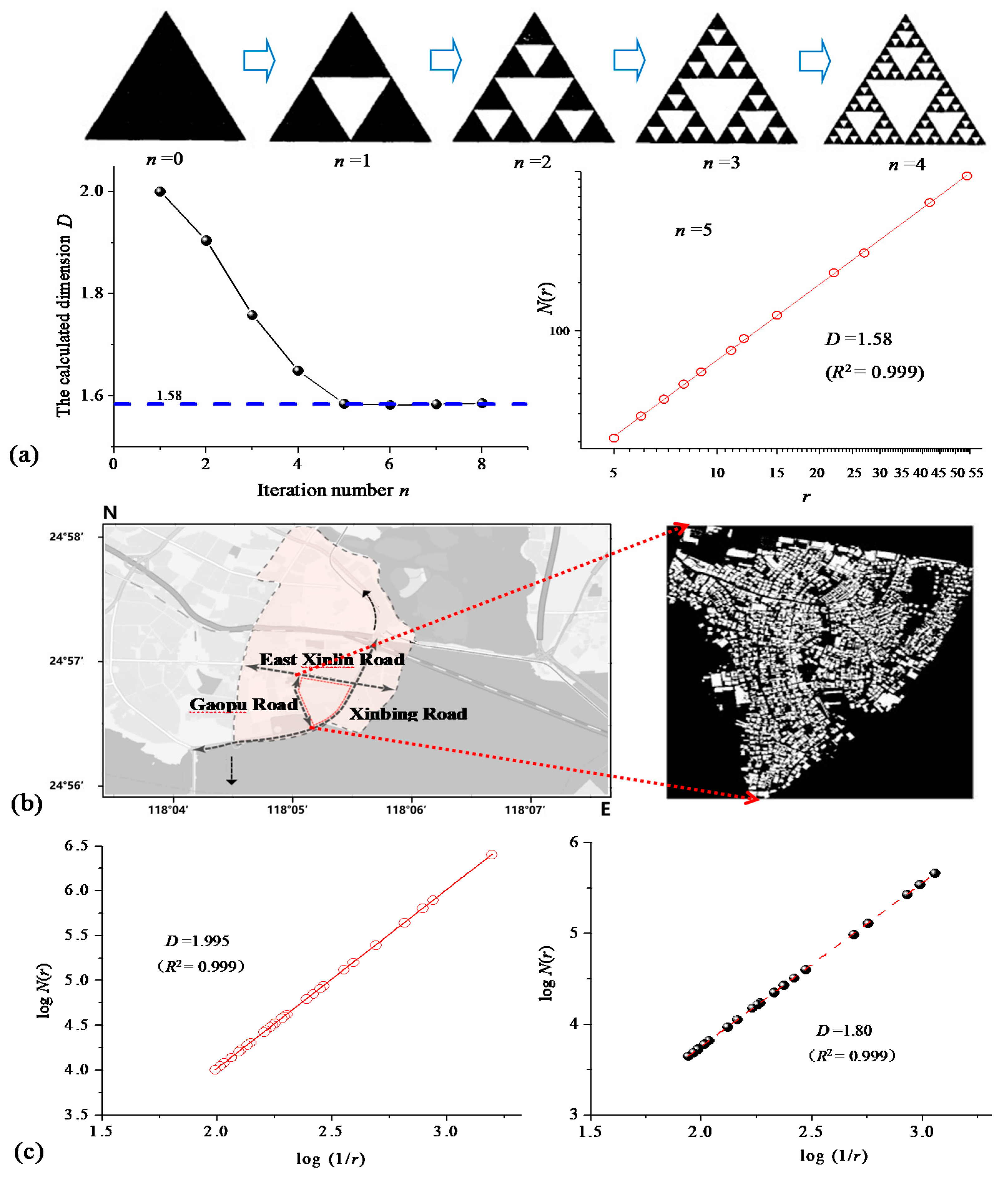
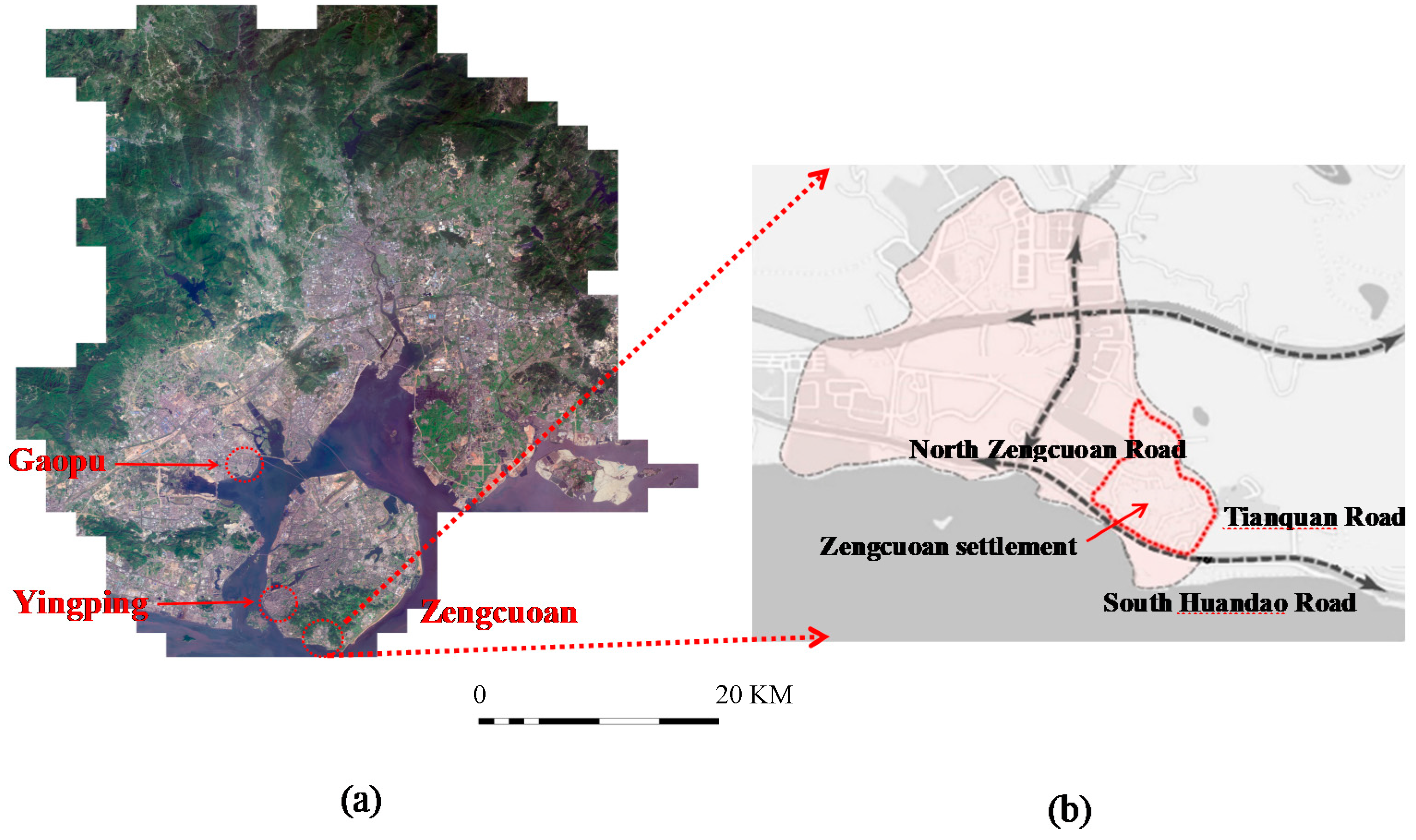


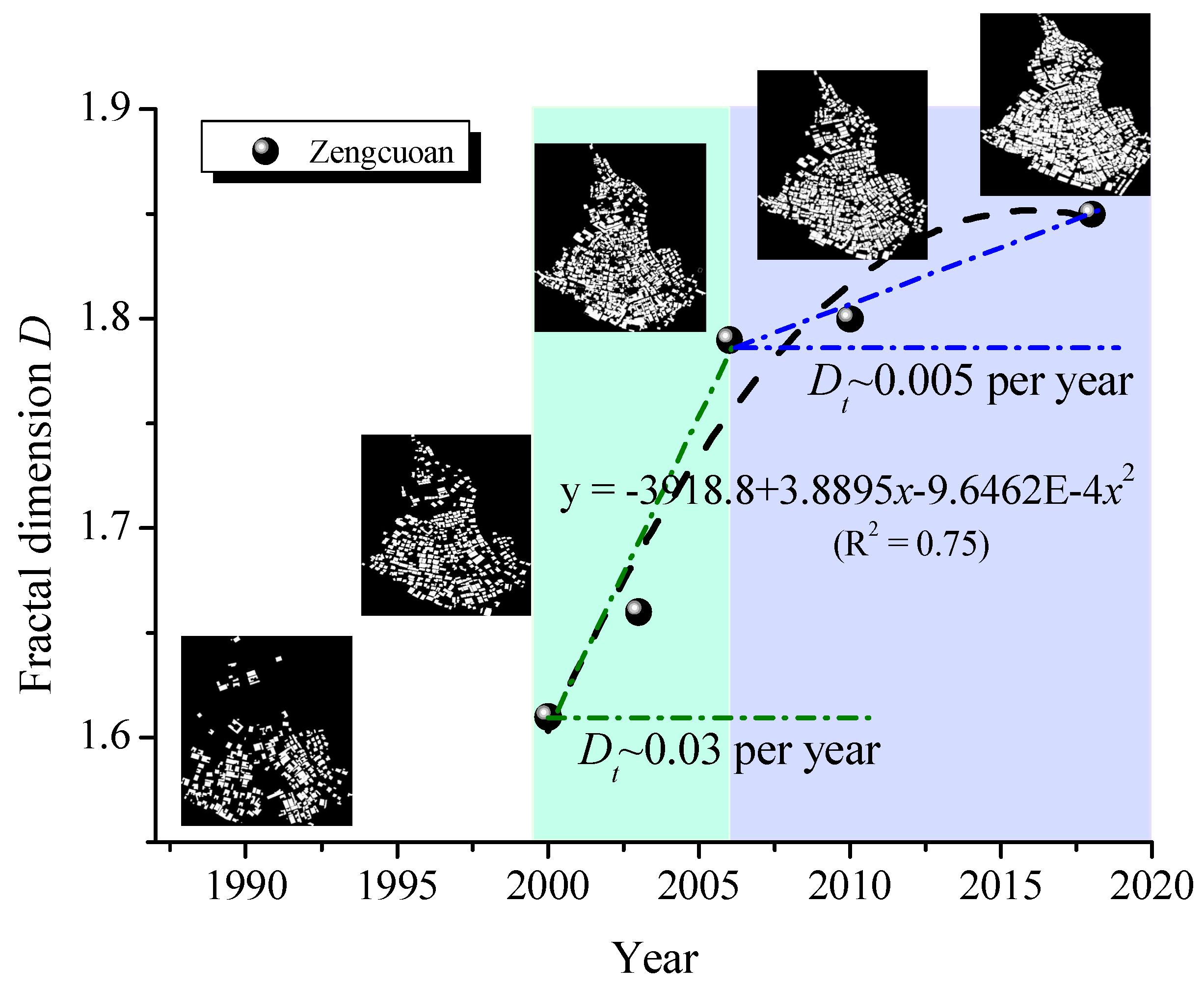
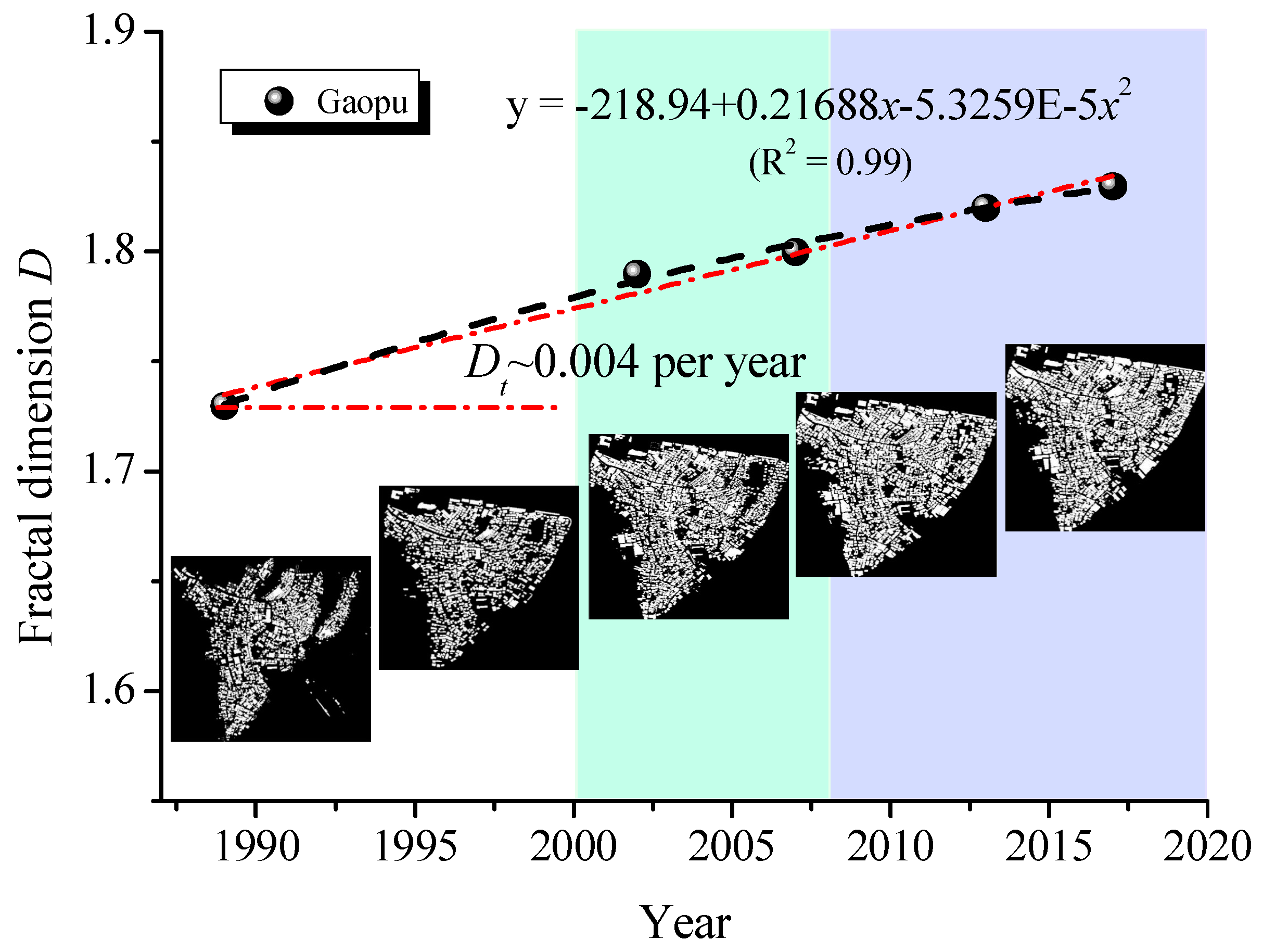
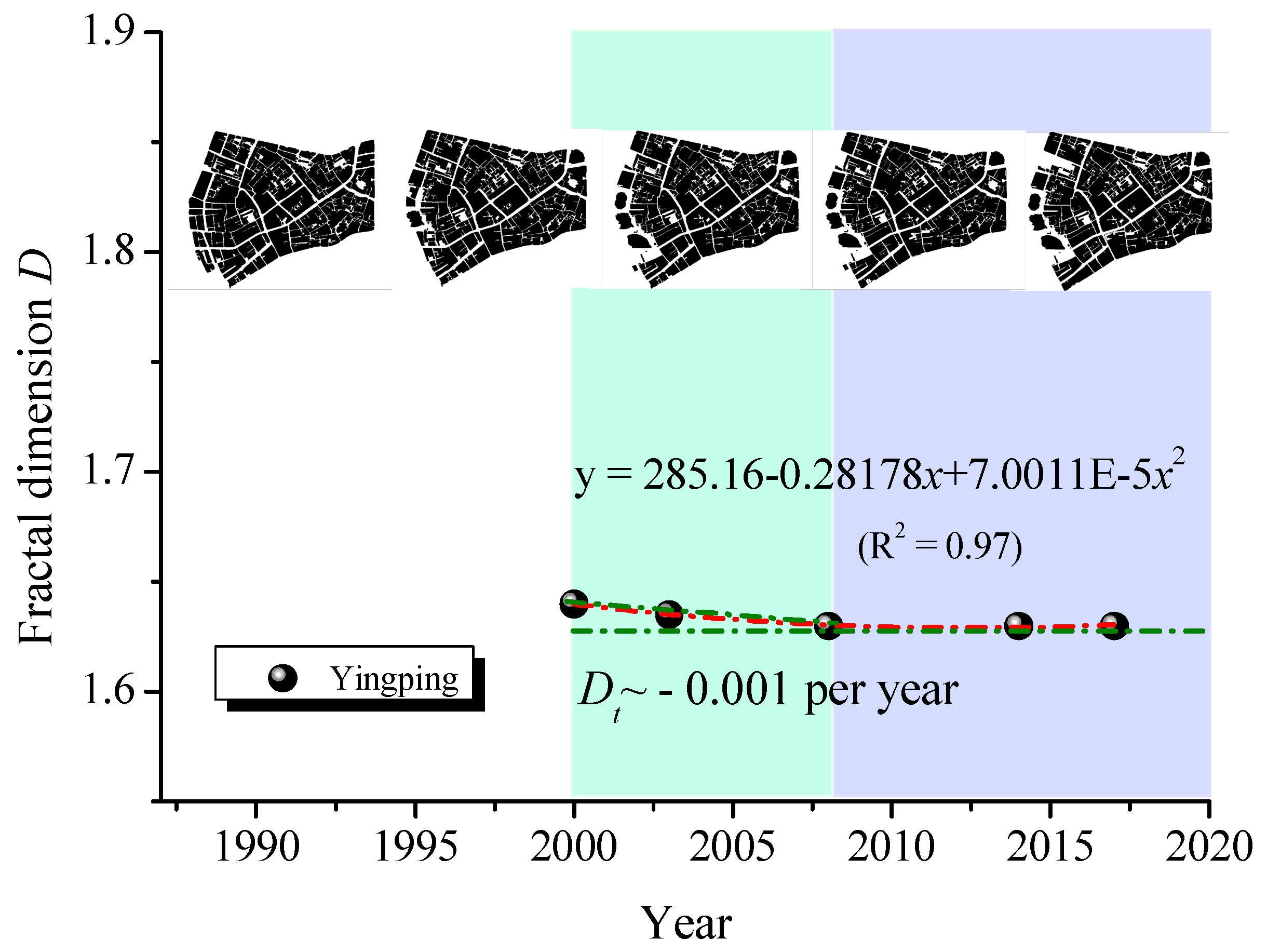
Publisher’s Note: MDPI stays neutral with regard to jurisdictional claims in published maps and institutional affiliations. |
© 2021 by the authors. Licensee MDPI, Basel, Switzerland. This article is an open access article distributed under the terms and conditions of the Creative Commons Attribution (CC BY) license (https://creativecommons.org/licenses/by/4.0/).
Share and Cite
Yu, X.; Zhao, Z. Fractal Characteristic Evolution of Coastal Settlement Land Use: A Case of Xiamen, China. Land 2022, 11, 50. https://doi.org/10.3390/land11010050
Yu X, Zhao Z. Fractal Characteristic Evolution of Coastal Settlement Land Use: A Case of Xiamen, China. Land. 2022; 11(1):50. https://doi.org/10.3390/land11010050
Chicago/Turabian StyleYu, Xiaojian, and Zhiqing Zhao. 2022. "Fractal Characteristic Evolution of Coastal Settlement Land Use: A Case of Xiamen, China" Land 11, no. 1: 50. https://doi.org/10.3390/land11010050
APA StyleYu, X., & Zhao, Z. (2022). Fractal Characteristic Evolution of Coastal Settlement Land Use: A Case of Xiamen, China. Land, 11(1), 50. https://doi.org/10.3390/land11010050





